Catherine Grove's Blog
January 22, 2025
What’s in a Name? Revisionist History
In researching 1843 Canada East census database a message popped up when I was about to enter ‘race’ warning me that some terms might be considered offensive today. Library and Archives Canada defended that these terms have been retained, in the database, to ensure that attitudes and viewpoints are not erased from the historical record.

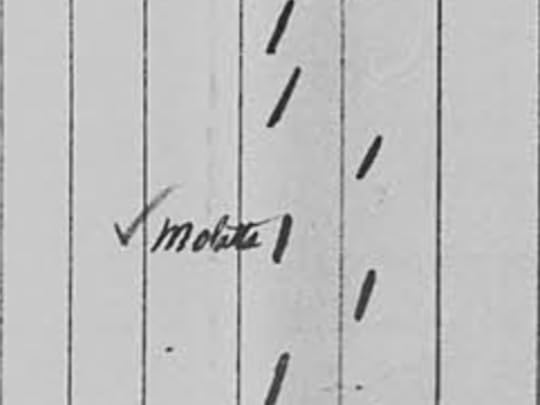 Mullato entry of my ancestor’s 1851 census
Mullato entry of my ancestor’s 1851 censusRevisionism is the theory or practice of amending one’s attitude to a previously accepted situation or point of view(1).
In 2020, the Quebec Government identified eleven places to be revised and renamed because they contained the N****word (2). Unfortunately, their decision to revise nomenclature threatens erasure of Black History.
Let me brief you with a few facts:
1—Slavery was legal in British North America (Canadian Colonies) until August 1, 1834 when ended by the Slavery Abolition Act of 1833 (4). The Act only emancipated children under age six. Others were to be retained, for up to six years as indentured apprentices, before receiving their freedom.
2—During the Independence Revolution of the American colonies, various British Royal Proclamations promised freedom and land for indentured servants and enslaved negroes of American Patriots in exchange for service to the British Army, in effort to undermine the economy of an American Republic(5).
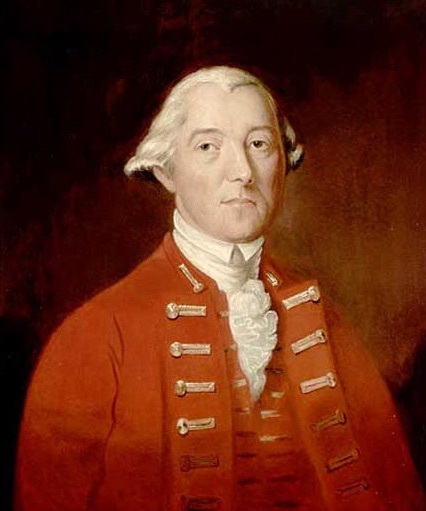
3—When the British evacuated the New American Republic, they evacuated thousands of formerly enslaved people, known as Black Loyalists. An inventory of these Free People of Colour was recorded in 2 ledgers, the Book of Negroes(6), commissioned by Sir Guy Carleton (Governor of British North America, 1785-95)
(Sir Guy Carleton, 1st Baron of Dorchester, 21st Governor of Quebec, 23rd Governor of the Canadas)
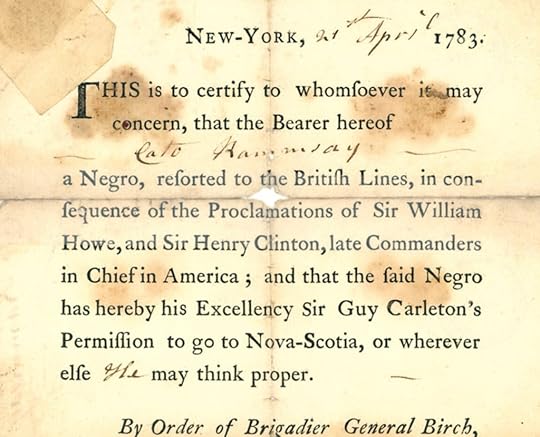
4—Tens of thousands of American colonists, loyal to the British Crown, migrated to British North America, primarily to present-day Ontario, Southern Quebec (Eastern Townships) and New Brunswick(7).
Many of these White Loyalist were farmers and business owner. Many also owned slaves who were not covered by the British Royal Proclamations. As a result, their workers remained ‘enslaved’ once in the Canadian colonies.
In the second parliament of Canada West (1797-1800) 14 of the 17 members were either slave owners or were from slave owning families(11). I will not discuss this peculiar situation in the Canadian colonies, whereby free property-owning Black farmers coexisted alongside enslaved Black workers of White farmers. However, I would venture this is why an ability to compromise is a Canadian value
A large Black population existed in the Canadian colonies, to be later augmented by an influx of up to 30,000 Black refugees from enslavement, known as the Underground Railroad.
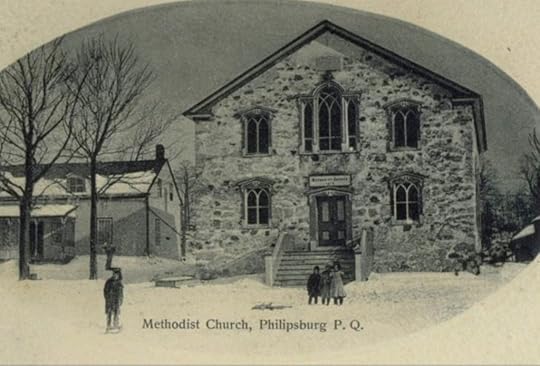
Near St. Armand Quebec is a cave that hid refugees of slavery, and the St.Philipsburg Methodist church (built 1819-to the left) that served as refuge for the Underground Railroad.(8)
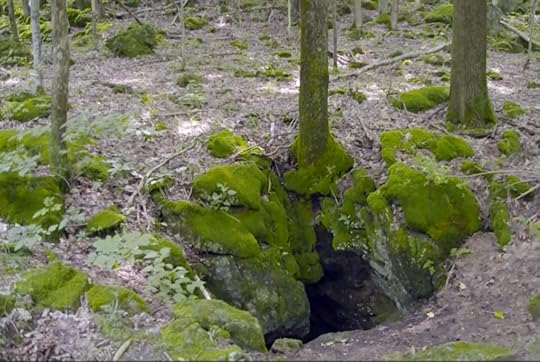
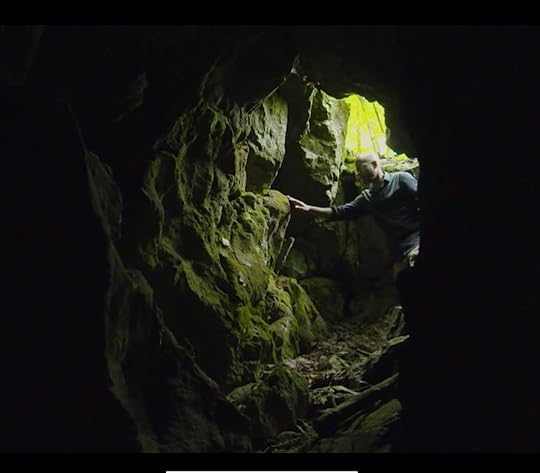 Refuge cave, St Armand, Quebec (8)
Refuge cave, St Armand, Quebec (8)Yet we know very little of Black history except through oral accounts, and geographic markers, linking to their location, incidents and experiences(8). Often this involved a racial identifier such as Negro, or the derogatory term N****.

It should be noted that the French word Nègre, can be translated as both Negro and N****.
In 2017, the province of New Brunswick rescinded those geographic names contain the N**** replacing them with names of Early Black Loyalists(9)(10).
Regarding Quebec, however, as far as I can find, little has been done to resolve the issue of the names, except to remove them from maps, or rename them with unrelated references. Effectively this erases evidence of the pre-Confederation Black Community, much as already be done for White English history throughout the province. For example, Montreal’s Dorchester Blvd (Named after Sir Guy Carleton, commissioner of the Book of Negroes, Baron of Dorchester and Governor General of Canada) was renamed to Rene Levesque, a separatist Premier of Quebec in 1987.
Examples of N**** geographic terms, removed from Quebec’s maps, and now difficult to locate:
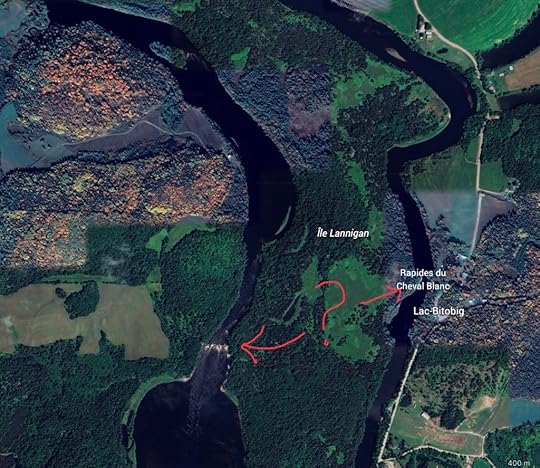
1-—N**** Rapids, on the Gatineau River, near Maniwaki, named after a black couple (unknown) that was found drowned here. Remains unnamed.
2—N**** River, tributary of the Tomifobia River, Eastern Townships, comes from a Black Family (1804) that farmed nearby. Renamed to Niger River in 2006.
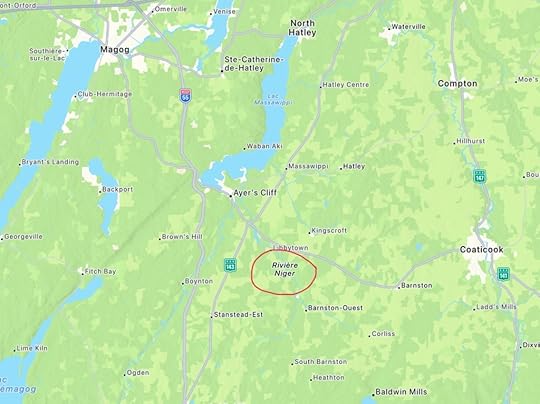

3—Lac a Ti-Nègre, near Shawinigan (also see above). Renamed, in 2015, Lac Honorè Gèlininas, in honour of the founding president of the Golden Age Club of Saint-Jean-des-Piles.
4—N**** Rock, slave and Black freemen cemetery near St. Armand, Eastern Townships. Accessibility limited since on private land.

Regarding N**** Rock, Dan Philip, president of the Quebec Black Coalition maintains that “Changing the name won’t change its history”(3) and he wants the name to stand.
Canada is a diverse tapestry of contributing fibres that strengthen our fabric. It is important our pioneer settlers have proper acknowledgement for their contribution to our History and culture. Though the nomenclature is offensive, the naming did have historical meaning. I leave with you a challenge…
Which is of greater offence, the name or being removed from History?
Let us open our understanding, as done by the New Brunswick Compilation Project, and form a compromise acknowledging our past and what we’ve learned from it.
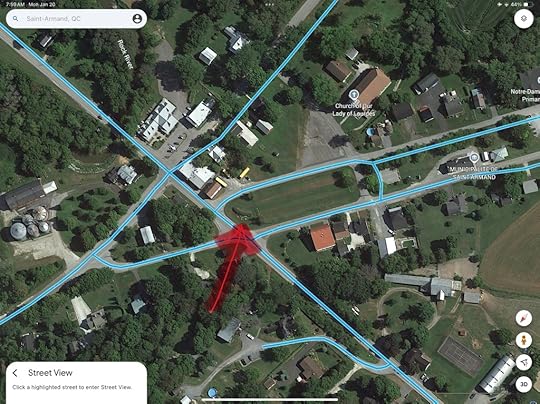 Google Earth location of St. Armand display
Google Earth location of St. Armand display 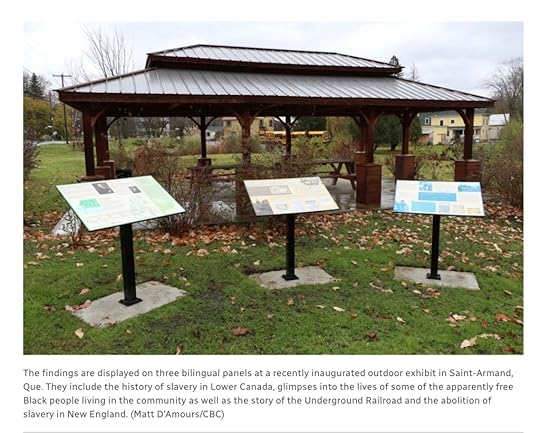 Modest display at St. Armand park (13)
Modest display at St. Armand park (13) References:
(1) Oxford Dictionary, Oxford Languages and Google
(2)The Push to Remove the N-Word name of English and French places in Quebec, July 1/20, cbc.ca
(3) Black rights group wants to formally recognize historic site with Racist name, Morgan Lowrie, Oct 2/16, cbc.ca
(4) Slavery Abolition Act, 1833, Natasha Henri-Dixon, Nov 5/2021, thecanadianencyclopedia.ca
(5)Lord Dunmore Proclamation(1775), Philipsburg Proclamation (1778)
(6) The Book of Negroes, Black Loyalists; Our History, Our people, BlackLoyalists.com
(7) Loyalists in Canada, Bruce G. Wilson, Aug 12, 2021, thecanadianencyclopedia.ca
(8) Ni**er Rock, Le Fabrique Culturelle TV, Tele-Quebec
(9) Geographic Place names changed as a part of Black History Complilation Project, Feb 28, 2012, New Brunswick, Tourism, Heritage and Culture
(10) New Brunswick renames 5 places with ‘Negro’ in their names, Feb 28, 2012, CTV news
(11) Black ENslavement in Canada, Natasha Henri-Dixon, Feb 9, 2022, thecanadianencyclopedia.ca
(12) Chloe Cooley and the 1793 Act to Limit Slavery in Upper Canada, citing: Robin W. Winks, The Blacks in Canada: A History. Montreal and Kingston: McGill-Queen’s University Press, 1997, p. 97., background to plaque unveiled,August 23, 2007, Ontario Heritage Trust and the Niagara Parks Commission, Heritagetrust.ontario.ca
(13) Black Cemeteries Force us to Re-Examine our History with Slavery, Charmaine A Nelson, Jan 30/2022, The Walrus
September 30, 2024
Anglo Vestiges of a Quebec Company Town
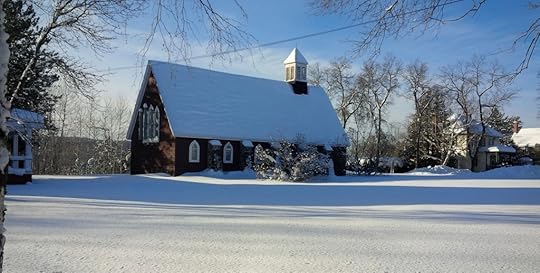
Resting deep within Quebec, they sit, a thorn in the side to some, a reminder of refuge to others, deconsecrated and repurposed.
Former Anglican Churches now serve as shops, studios, museums, Bed and Breakfasts, homes, and alternative places of worship. In Abitibi, Mauricie, Saguenay and the St. Lawrence North Shore, they echo a world no longer—an English speaking community of a Quebec company town. (Former St.Bede’s, Rouyn at right)

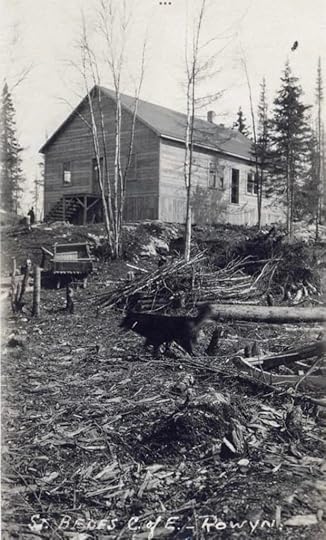
To understand how they came to be here one must return to the world to which they were invited.
(St.Bede’s, Rouyn, 1926, at left)
Quebec of the early 1900’s offered immense undeveloped resources in mining, lumber, industry and hydro-electric power. These ‘unclaimed’ riches waited in vast unpopulated areas. Only a few brave French-speaking colonists wrestled a living in this forested wilderness. Engineers, mechanics, construction and skilled labourers were needed to develop the potential for American and English investors.
Quebec’s education system could not provide for such an undertaking. Until 1964, the province did not have public education. Two parochial systems, one guided by the Catholic Church (French language), and one other run by the Protestant church (English language) served the needs of Quebec (1).
(LaTuque, 1961, majority of teachers from religious orders (3))
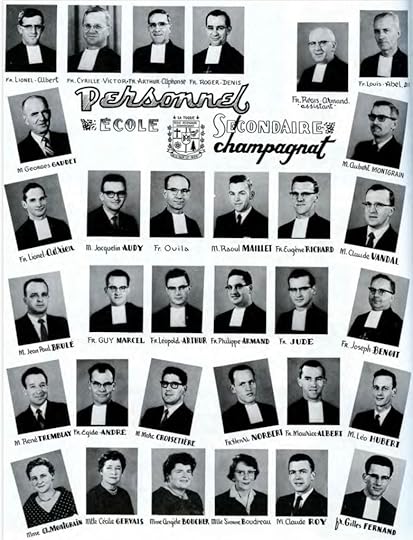
Under the Quebec Act of 1774 (4), Roman Catholic Faith and French Civil law was preserved for French-speaking inhabitants of Quebec. This was affirmed, post-Confederation, under the Quebec Council of Public Education(2) with parochial schools.
Based on an earlier Jesuit tradition Quebec French education was provided through classic Catholic colleges in a strong curriculum oriented towards theology, logic, philosophy, classics and letters with little exposure to mathematics and science. Most of the colleges were private, limiting education of those who could afford it.
Quebec could not meet the need for Professional Engineers and technical competence. Neither could Canada. Only thirty years previous, in 1887, Canada began awarding engineering degrees(5). Before then, engineering was viewed, primarily, as a military occupation. Consulting firms were associated with British or American principals.
By 1919, 4,500 engineers were in professional practice in Canada, very few were French Canadian. Capitalists were forced to hire English engineers from Britain or the United States to undertake the development of roads, railways, manufacturing, mining and hydro-electric power.
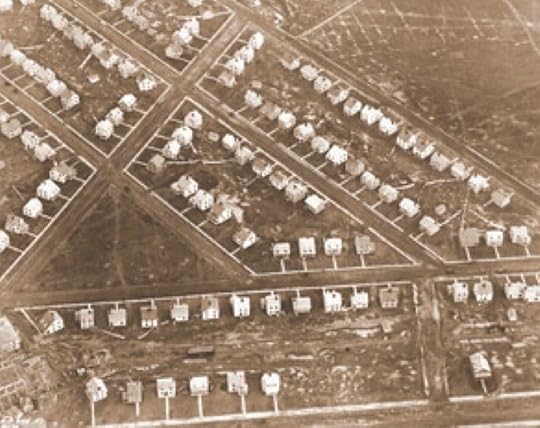
Recruitment was undertaken from the United States, Great Britain, and other parts of Canada and necessitated building of company towns with homes, schools and churches to attract skilled employees to rural Quebec.
(Arvida, 1926, at left)
English became the dominate language of resource development and day-to-day implementation of technical expertise in Quebec. This was furthered by the need to communicate with English and American capital investors such as Sir William Price (Saguenay) and the Brown Family (Mauricie).
Catholic and Protestant churches and parochial schools needed to be built for these company towns. Both Roman Catholic and Protestant Anglican Churches had undertaken mission work in these undeveloped territories mapping Canada into geographic governance dioceses (6).
Established for over 400 years, the Anglican church was familiar to both British (Church of England) and Americans (Episcopalism). Flexible Anglican theology accommodated the spectrum of Protestant principles and had a strong foothold in Quebec’s parochial education system (7) providing foundation to many Canadian universities. Quietly evangelical, they collaborated well with Roman Catholicism and made no judgement of dancing, moderated alcohol use, smoking and other such sources of merriment. As a result, the Protestant Anglican Church presented a ‘middle road’ solution for Company sponsorship.
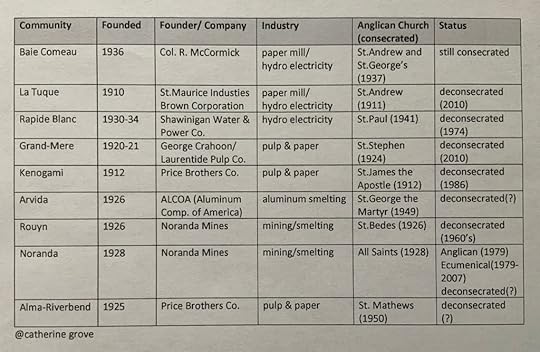 Selective list of company-town Protestant churches
Selective list of company-town Protestant churches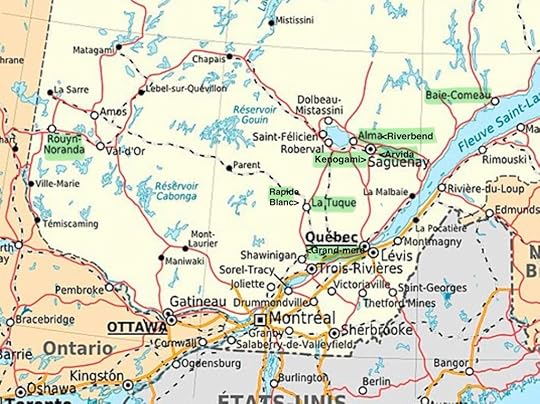
These churches provided more than a place for worship to transplanted English-speaking population. (Location of selected company towns in map, at left)
Welcoming children through christening/baptism, showers Sunday schools, annual picnics, they supported life’s mile-stones with weddings, funerals, cemeteries and memorials. Through two World Wars, the Great Depression, and the ‘booming’ development of post-war Canada(1910 to mid-1960’s) they provided an English social centre.
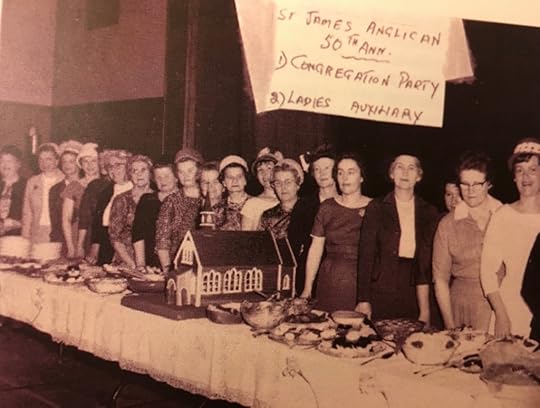
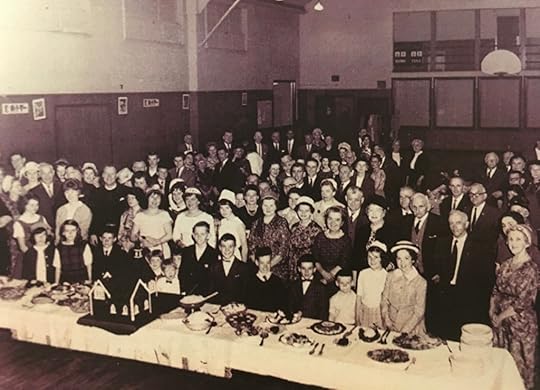
Their Ladies Auxiliaries (12) raised funds for charity through Christmas bazaars, and provided ‘drop-ins’ for youth to gather, Brownie, Guides and Scout troops, and Christmas pageants unique from the surrounding French Catholic community.
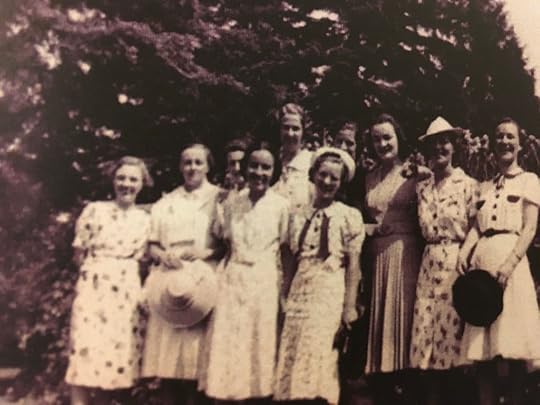
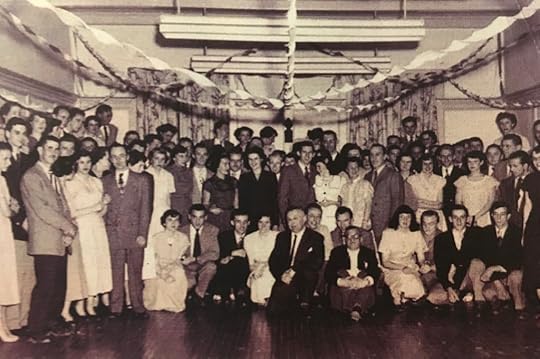
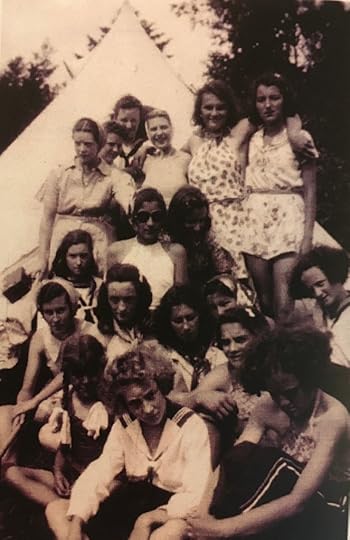
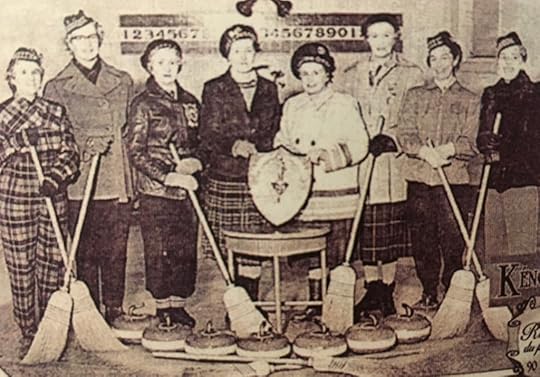
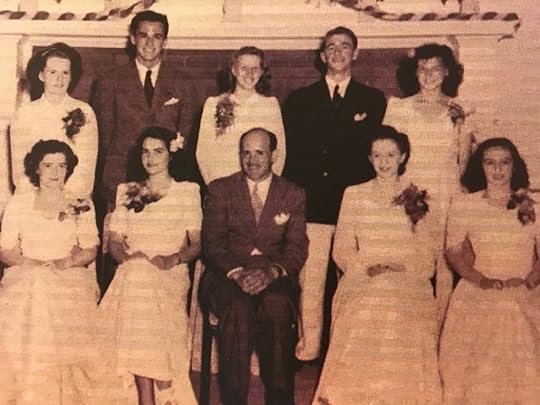 Kenogami,1940’s (12)
Kenogami,1940’s (12)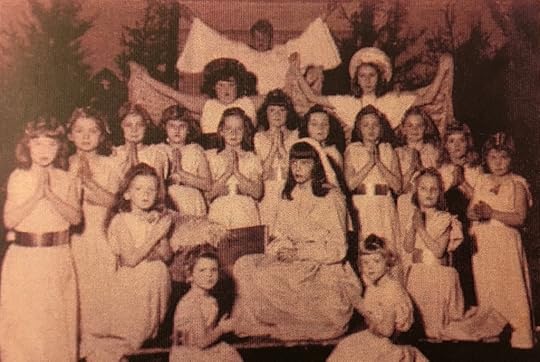

During the mid-1960’s, Quebec underwent a cultural upheaval known as the ‘Quiet Revolution’ (8) resulting in liberal political change. The 1964 Parent Report challenged Roman Catholicism’s hold on education and proposed a unified democratic education system resulting in increased secularism.
This liberal political wave welcomed changes to social health insurance, women’s rights and nationalized hydro-electric companies.
Quebec quickly adjusted to the educational needs of industry and by the late 1960’s merged private classic colleges into a publically funded system of vocational and university preparation colleges known as CEGEPs (English translation of acronym – General and Vocational colleges). French University programs were enhanced to meet the needs of Science and Engineering.
This Quiet Revolution efficiently revised Quebec’s industry and resource development. Concurrently, former paternal companies evolved into international conglomerants. Hydro-electric power was now in the government’s domaine of Hydro-Quebec and French Professional Engineers and technically skilled workers were available to address industry’s need, Further legislation of the 1970’s (Bill 101, 1972, (2)) led to mandated French usage in both public and private industry.
Quebec’s secularization, coupled with the mandated use of French, resulted in an exodus of English youth and retirees from rural Quebec (10). English speakers in rural company towns fell from roughly 30% to less than 1% population. Anglo Quebec outside of Montreal is on the verge of disappearing.
Some English multi-grade public schools remain, though greatly reduced in population: Noranda High School (in Abitibi), La Tuque High School and Shawinigan High School (in Mauricie), Riverside High School (in Saguenay), and Baie Comeau High School (St. Lawrence North Shore). Students of these schools are in possession of a ‘Certificate of Eligibility’ because of a parent having attended a Quebec English School (11). Many are offspring of a mixed language marriage and might be considered to have French as a ‘mother’ tongue.
Company-town Anglican churches have not fared as well.
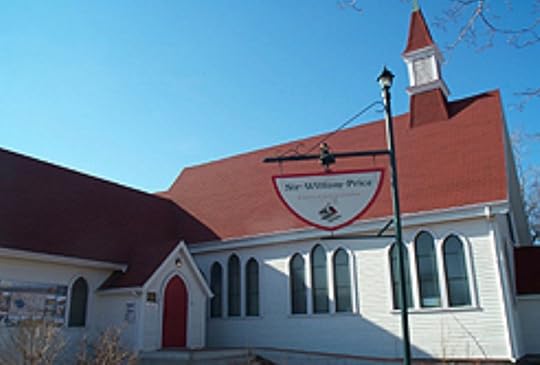 St.James the Apostle—Sir William Price Museum
St.James the Apostle—Sir William Price Museum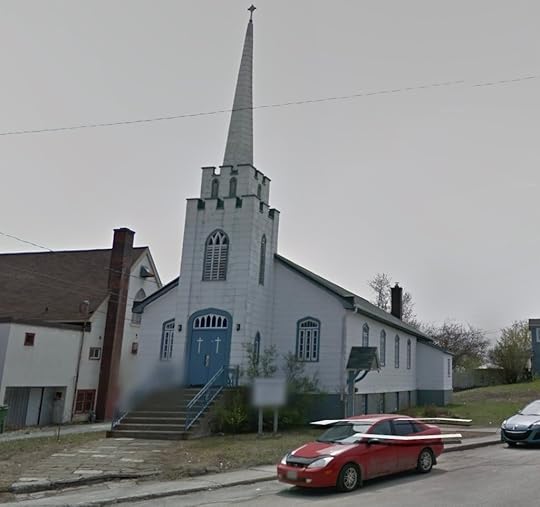 All Saints — Asemblee
All Saints — AsembleeChetienne de Rouyn-Noranda
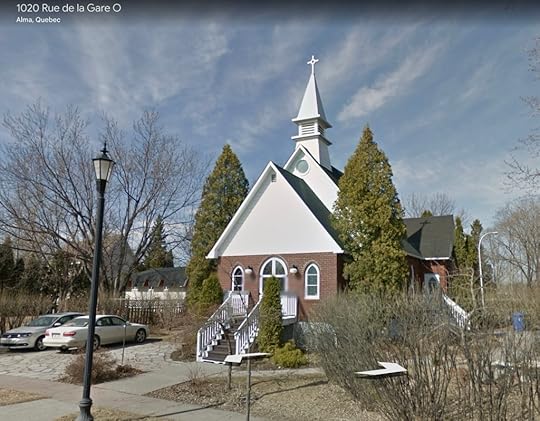 St.Mathews —private home
St.Mathews —private home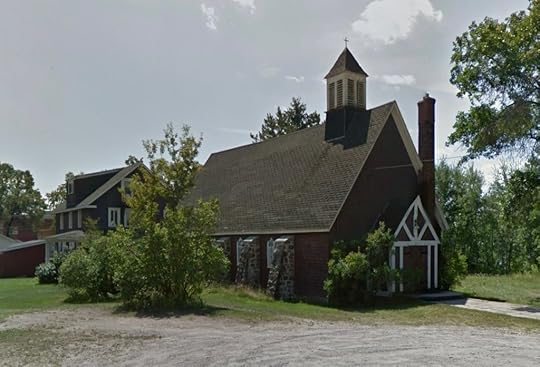 St.Andrew —hospitality venue
St.Andrew —hospitality venue St.Bedes—consulting firm
St.Bedes—consulting firm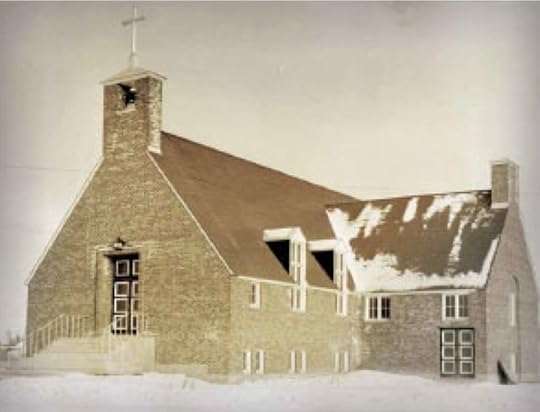 St.George the Martyr — Eglise Evangeliste Baptiste
St.George the Martyr — Eglise Evangeliste BaptisteSilently they remain, a vestige of the once thriving English community that harnessed resources, and built industries bringing prosperity to Quebec.
Here is the church and here is the steeple.
Open the doors and see all the people.
Close the doors and let them pray.
Open the doors and they all walk away.
References used by Catherine Grove:
Classical College (Colleges Classiques). Wikipedia1869 Quebec Council of Public Education; 1977 Bill 101- priority of French in law, public administration and education in Quebec, Catholicregister.orgAlbum Souvenir du Cinquantenaire des Freres Maristes, La Tuque, Ecole St.Zephirin, Ecole Secondaire Champagnat, 1911-1951The Quebec Act of 1774, the Canada Encyclopedia (May 11, 2020), thecanadianencyclopedia.caCanadian engineer in History; A Thumbnail Sketch, Andrew H (Drew) Wilson, FCAE, May 2020, Prepared at the request of the Canadian Academy of EngineeringThe Anglican Church of Canada, Map of Ecclesiastical Provinces, Anglica.caAnglicanism in Canada, (February 6, 2020), thecanadianencyclopedia.caQuiet Revolution, (March 4, 2015), thecanadianencyclopedia.caHalf of Dioceses of Quebec Parishes Set to Close, December 2014, Anglican.inkAnglos Leaving Quebec Region, January 25, 2023, CBC.caAccess to English Schools in Quebec: The Certificate of Eligibility and Other Options, (2024) Deucalion.qc.caThe history of the English Community at Kenogami, Quebec (1910-1951), David & Clark McIntoshSeptember 9, 2024
The Lipstick Effect: Beguiling Empowerment, Beauty as a Duty, and an Economic Indicator
Undocumented history alleges beautician Elizabeth Arden handed out thousands of bold red lipstick tubes to New York suffrage marchers as they passed her Fifth Avenue salon in 1912.

Photographs of both the May and November suffrage parades show no evidence of ‘painted lips’ on these protestors demanding their right to vote. Arden, herself a suffragette, shrewdly linked her cosmetic products with female suffrage and empowerment (1).
Prior to WWI, red lipstick and cosmetics were viewed as the domain of theatrical actresses, prostitutes and women of low morals. Yet, as the call for suffrage intensified, rallies in Europe, Australia and New Zealand reported an increased appearance of provocative red lips shouting slogans. Red lipstick had become a symbol of civil disobedience (2).
During WWI (July 28, 1914 to November 11, 1918) women were called to stand-in for fighting men in factories and hospitals as well as replacing them in such work as tram drivers, delivery staff and postmen.
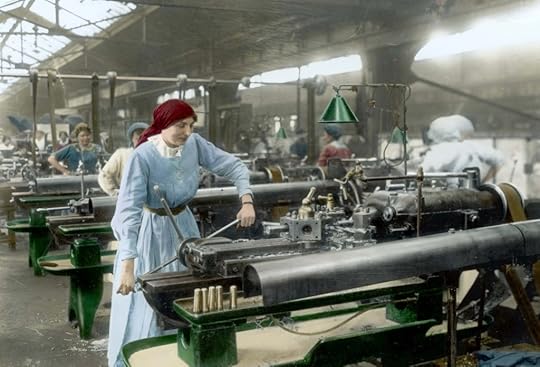
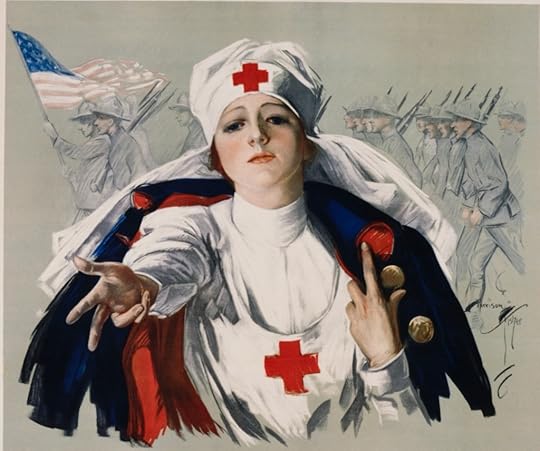
Lipstick was encouraged to emphasize a ‘duty to remain a woman’ while undertaking these male endeavours. Care of appearance was viewed as patriotic, and promoted by both Elizabeth Arden and her competitor, Helena Rubinstein, another cosmetic tycoon of the time.
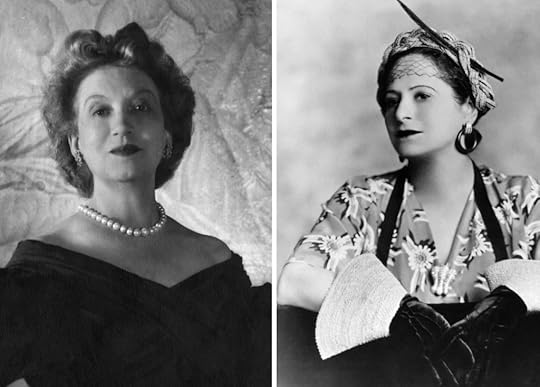 Elizabeth Arden (left) and Helena Rubinstein (right)
Elizabeth Arden (left) and Helena Rubinstein (right)Women’s contribution to the war effort resulted in major Western Powers granting women the right to vote during and after the war. Suffrage was granted in Canada (1917), Germany (1918), the United Kingdom (1918 for property-owning women over the age of 30 and in 1928 for all women) the Netherlands (1919) and the United States (1920).
Society did not return to pre-war conditions. An unsuccessful campaign against cosmetics, particularly against red lipstick, failed.
The increasing popularity of a movie industry and glamorous Silver Screen actresses influenced society’s acceptance and even coined a new word, ‘makeup’ to replace the term, ‘cosmetics’(3). Bold red lipstick, along with mascara and blush, had become affordable and readily available at department store beauty counters.
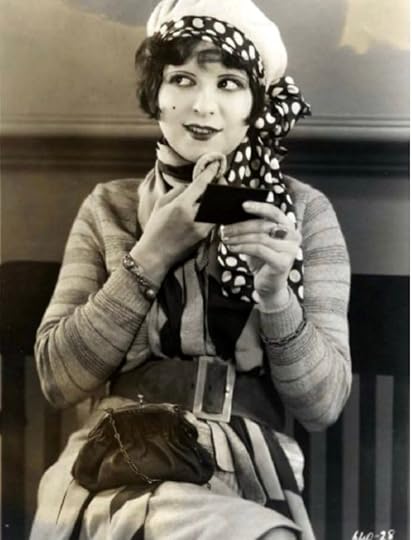
With the onset of the Great Depression, lasting a decade form 1929 to WW II, lipstick remained an affordable luxury, providing a touch of glamour in an economically bleak world.
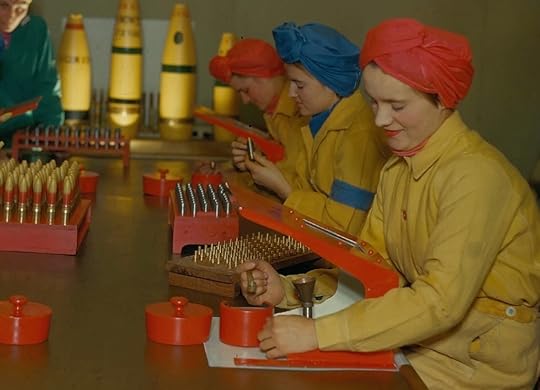
With WW II and women’s return to standing-in for men in ammunition factories, construction work and other non-traditional work, women were again encouraged to see ‘beauty as your duty’
Production of war supplies required protective glasses, overalls and scarf covered hair; red lipstick was a safe morale booster and sometimes distributed by war production outlets along with safety equipment.
 Elizabeth Arden’s civilian shade of Victory Red
Elizabeth Arden’s civilian shade of Victory RedMore importantly, however, red lipstick a took on a patriotic symbol for Adolf Hitler hated red lipstick and tried to ban cosmetics in Nazi Germany(4). His distain of lipstick came from the Nazi position that natural ‘Aryan’ beauty should be unadorned.
Winston Churchill,the wartime British Prime Minister, therefore encouraged the use of red lipstick. Strict rationing, significantly, did not apply to lipstick production because of its morale importance.
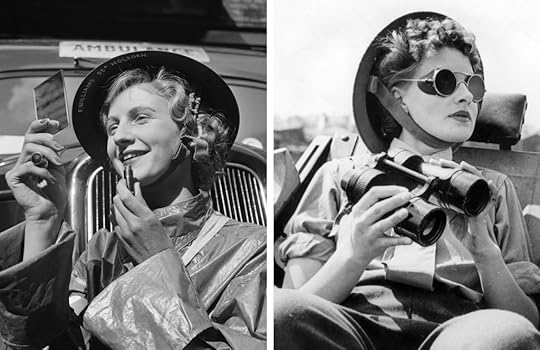 Ambulance driver and skyline observer
Ambulance driver and skyline observer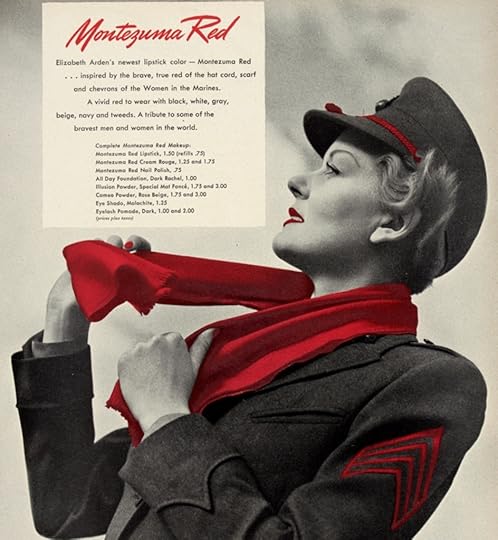
‘Lipstick is your weapon!’ became a slogan for American female military personnel. Elizabeth Arden was commissioned by the American Army, to create a red lipstick (along with cream rouge and nail polish) to match piping and chevrons of the woman’s uniforms.
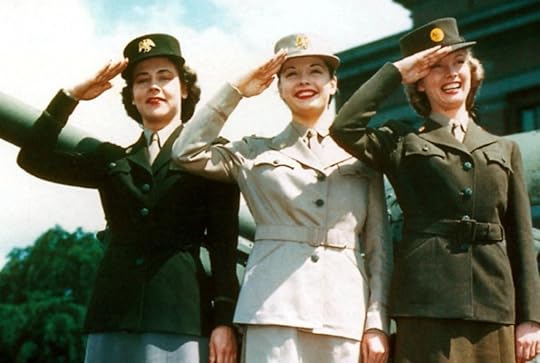
‘Montezuma Red’ lipstick was distributed to military women in their official kit. Arden also created ‘Victory Red’ for patriotic civilian women.
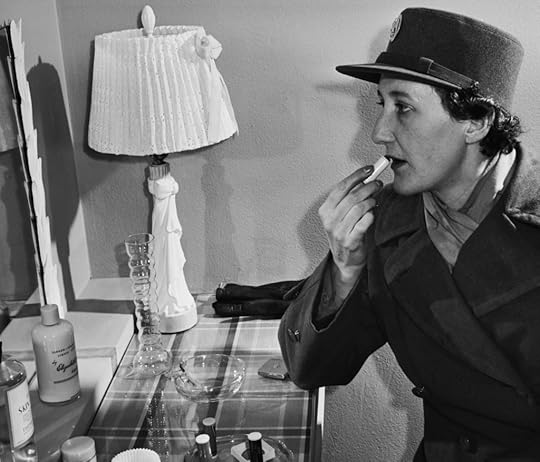
In the post-war decades, red lipstick was relegated to the fashion world. Other colours were embraced, such as white.
 60’s lipstick and 80’s lipstick shades
60’s lipstick and 80’s lipstick shades
The 1990’s saw an emergence of ‘Lipstick Feminism’, a movement of ‘third wave’ feminism resulting in a protest boycott of items considered to be feminine (5). Red lipstick reappeared as a symbol of protest against sexual violence.
 2018 Nicaraguan protests, 2019 Chilean protests
2018 Nicaraguan protests, 2019 Chilean protestsThe Lipstick Index (6)(7) emerged as an economic indicator, first observable during the Great Depression. This index posits that lipstick sales rise during periods of economic recession. This is because, as consumers cut back on big ticket purchases in times of uncertainty, they still seek small indulgences. Purchasing a lipstick can provide a psychological boost in tough times. This ‘Lipstick Effect’ occurs across generational and income brackets and is believed to be driven by a desire to maintain appearance of social status during uncertainty.

My red lipstick is ready for active duty, safely stored in my grandmother’s eel skin 1940’s holster, within my purse.
Morale booster, weapon, patriotic duty, optimism, civil disobedience or my economic indicator, I never leave home without it.
References:
(1) Elizabeth Arden and the Suffragettes, March 27, 2024, makeupmuseum.org
(2) Red Lipstick, a Symbolism of Women’s Struggle for Their Rights and a Weapon over Nazism, Serhill Pyvovarov, Yevgen Spiren, June 19, 2022

(3) 1920’s Makeup and the Cosmetic Industry, Karen’s blog, wardrobeshop.com
(4) Behind the Color; 1941 Victory Red, besamecosmetics.com
(5) Lipstick Feminism, Neoliberralism and the Undoing of Feminism, Arianna Marchetti, April 12, 2022, youngfeminism.eu
(6) The Lipstick Effect Powers Beauty Sales Despite Economic Uncertainty, Shelley E. Koran, July 11,2024, Forbes
(7)Lipstick Effect, Definition Theory, Value as Economic Inidicator, Adam Hayes, July 31, 2024, Investopedia
April 2, 2024
Interview with Mary Haskett: Kept Safe

Good morning Catherine. I would like to ask you a few questions about your interesting historical novel Kept Safe.
Did you have knowledge of the weather patterns which you describe in Kept Safe?
Absolutely. From 1808 to 1815 a series of volcanic eruptions culminated in the massive eruption of Indonesia’s Mount Tambora in April 1815.
These eruptions produced a substantial build-up of atmospheric dust in the stratosphere, blocking out sunlight for almost 2 years.
A ‘volcanic winter’ resulted in the Northern Hemisphere, dropping earth’s temperature, and producing extreme climatic aberration. The greatest effects were experienced in 1816, referred in historical accounts as ‘The Year Without Summer”.
At that time Europe was in economic slump, recovering from the Napoleonic Wars and, in Canada, the American War. With the extended Volcanic winter came massive crop failure from this extreme cold and incessant rain. Farmers fell into debt, the cost of food surged, and food scarcity, starvation and disease occurred throughout the Northern Hemisphere.
Olivia arrives at the dawn of this climatic event; extreme weather is definitely a factor in the plot.
Why did you give Wesley a role that would keep them apart for prolonged periods of time?
Without giving away a spoiler, Wesley’s post-war responsibilities are consistent with what would be expected of a British Officer in post-war Canada where the British Military still held legislative authority.
Captain Wesley Bryson investigates war compensation property claims throughout Upper Canada. As an Officer’s wife, Olivia is required to accommodate and support his responsibilities. Accompanying her husband to the frontier would interfere with completion of his duties.
Did you study the types of sewing, dressmaking and materials used to give it credence in the novel? How did you learn so much about styles?
For Regency upper-class women, decorative stitchery provided a creative outlet, in making pillows, fashion accessories and less functional decorative objects. Olivia was able to apply these skills once she overcame her class prejudice to doing the work of a seamstress.
As an amateur historian, I have belonged to several historic societies hosting many informative presentations and publications. While living and traveling in the United Kingdom, I visited many excellent local museums and manor homes that had displays on ‘fashion,’ materials and functionality. On social media, I follow several women that I would consider experts in this field.
In historical fiction the conditions under which a character lives must be appreciated for their restrictions on what is possible. Clothing denoted one’s status in society. Excellent deportment, a reflection of this status, was assured at the expense of movement. The higher a woman’s status the greater clothes restricted her ability to do physical labour, the work of servants, not ladies.
For Wesley to request Olivia to be ‘uncorseted’ was shocking to her. The term ‘loose woman’ comes from a perception that the looser a woman’s corset’s lacing, the freer her inclination to indulge in moral ‘shenanigans.’ Furthermore, a women’s underwear was open at the crotch, being simply two separate pantalettes tied at her waist. This enabled an ease to ‘void,’ but it also made ‘looser’ women more vulnerable to attack.
Did you have to do further research (of Olivia, Rosetta, Annie, and Sally) noting their vastly diverse backgrounds?
In my blog Catherinegroveauthor.ca, I have published some of my research.
I write to promote reconciliation. With the interactions of these diverse women, I endeavor to share laughter, shock and even some tears through their reconciliation and friendship growth. Inspired by true accounts, they are representative of three influential groups left out of Canadian history: Country Wives, Camp Followers and African Refugees from enslavement.
Refugees from American enslavement, post War of 1812, were the beginning of the ‘underground railway’, whereby between 30,000 to 50,000 migrants came to Canada. This reveals a peculiar compromise in Canadian history. Slavery was not abolished until 1832, yet Black refugees were welcomed and viewed as useful in undermining the American Republic’s economic dependence on slavery. The British military actively recruited Black men. Though restricted to the ranks, they were granted one hundred acres of Canadian land upon demobilization. I descend from one such recruit.
Viewed as loyal British subjects, Black settler migrants were also given land and armed to serve as ‘shield settlements,’ positioned to defend Canada from post-war American invasion through Georgian Bay or across Lake Erie.
Country Wives form the foundation of economic development and early settlement of Canada. Marriage of Indigenous women, following Indigenous practices, was respected until mid-1800’s. I recently wrote a blog on these marriages and their immense contribution to the fur-trade and exploration of Canada. If not for their assistance Canada would not have expanded peacefully and Western Canada might have been annexed by the American Republic. The wife of Sir James Douglas, first Governor of the colony of British Columbia was a Country Wife. They later ‘churched’ their marriage.
To sum it up, the friendship of these diverse women is an example of both ‘iron sharpens iron’ and the beneficial Indigenous ‘companion planting’ of the ‘Three Sisters’ of squash, beans, and corn. It is my hope that a similar reconciliation and strength will result within Canada’s diversity.
Did you ever light a fire in the way described in your novel?
My father taught me to fish, hunt and glean edible food from the bush but he always brought matches on our forays.
After watching many You-Tubes, I unsuccessfully tried to light a fire. Craig Macartney, my editor, acquired a flint and was able to successfully light a fire this way. He suggested a few revisions to my description.
Was smoking a customary practice?
It was indeed. By Regency time sniffing snuff (powdered tobacco) was considered polite for both women and men of the upper-class.
In the lower-class, smoking a pinch of tobacco in a small clay pipe was common and encouraged for both men and women. It was observed that smoking was a deterrent to the Ague (mal-air or malaria), believed to be caused by bad swampy air. This was likely true because tobacco smoke would have kept away mosquitos—the real cause of Ague.
Voyageurs used the length of time to smoke tobacco in a clay pipe to measure distance and time. Smoking was used by the military and their accompanying families to provide a break in the monotony of marching and to stave off hunger and combat weariness.
In addition to the above, Indigenous peoples used tobacco for both social and religious purpose.
Is it possible there are descendants of wolfdogs today, like Gizzy?
Yes. I’ve admired wolfdogs from a distance. Several breeds of wolf dogs exist today. They are usually 2 to 3 generations from being 100% wolf. Highly energetic and social, they are also tenacious and independent. If properly socialized at an early age, they are good companions for humans.
Where can readers purchase your books?
Kept Safe is available in e-book form from Amazon and Apple Books. The paperback is orderable through Indigo-Chapters. Paperback copies are available at the Ottawa Public Library and the Arnprior Public Library. I will also be in Perth, April 27, selling my book at the Perth Festival of the Maples.
Thank you, Catherine, for a fascinating peep into your novel.

Mary Haskett is author of the award-winning ‘Reverend Mother’s Daughter’, her true life story. Other works include ‘India My Calling’, the story of Jean Darling, and ‘Journey to Joy’, a wartime novel of love and redemption.
March 8, 2024
Farmborough, Quebec — Erased but not Forgotten
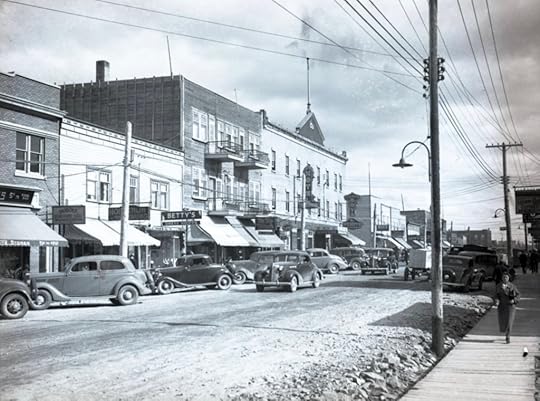 Main Street, Rouyn, Quebec, 1935
Main Street, Rouyn, Quebec, 1935Quebec of the 1930’s was still colonizing crown land, awarding lots of 100 acres property in exchange for clearing and residing on the land for a pre-determine inflexible time period. This Abitibi-Temiscamingue crown land was within the unceded territory of the Algonquin people (2) and part of the Ottawa River drainage basin.
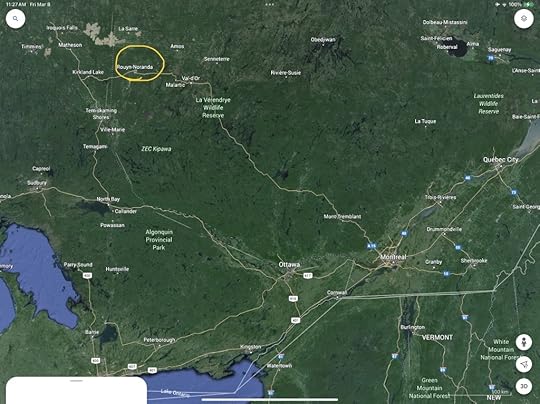
There was no public school option in Quebec of the 1960’s. Therefore, the Protestant School system provided the only alternative to French Roman Catholicism. Post-WW2 refugees introduced diversity of language, culture, colour, and creed merging within a common English Protestant education system.
Ukrainians, Poles, Germans, Lebanese, Indigenous, Metis, West Indians, East Indians, free-thinking Roman Catholics and even a few Anglo-Saxons protestants. Our school uniform failed to hide economic disparity: socks held up by elastic bands, thread-bare shirts and coats, scuffed shoes and kitchen haircuts. Professionals, miners, service people, subsistent farmers and rugged individuals dwelt together, in this northern mining town.
One particular school group stood out in this disparity, for their fierce loyalty to each other. Defiant, gritty and predictably late because of road conditions, they poured from a school bus. The rest of us ‘townies’ had to walk to school through omnipresent smelter haze. At the close of school day, they badgered the driver for mercy and wait for those poor individuals doomed to detention by a particularly vigilant science teacher. That battered bus was their sole means home, 13 miles out in the bush.
These were the Farmborough people (1), the stoic remnant of a 1930’s settlers from a depression-era scheme to provide opportunity to economically ‘disadvantaged’ people of Southern Quebec: slum clearance—to put it bluntly—of out-of-work factory workers.
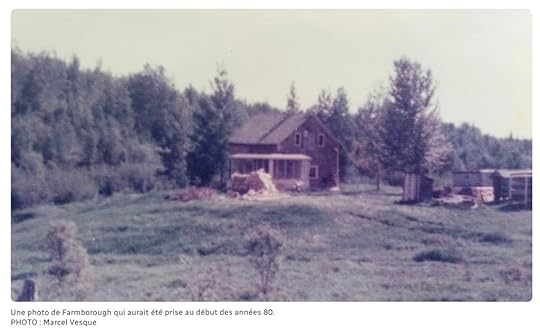
“They pulled us straight off the streets of Montreal and Quebec City,” reported a Farmborough resident, Herbert Moyle(1).
Both Roman Catholic (RC) and Anglican (protestant) churches were supportive of this ‘Back to the Land’ scheme as a means to strengthening the grip on their faltering congregants and provide opportunity. Taking a lead, RC settlement began to populate Abitibi in the 1920’s. This colonization is vividly described in the 1993 TV series, ‘Blanche’, the story of a frontier nurse ministering to settlers while battling the RC church’s dominance over struggling lives.
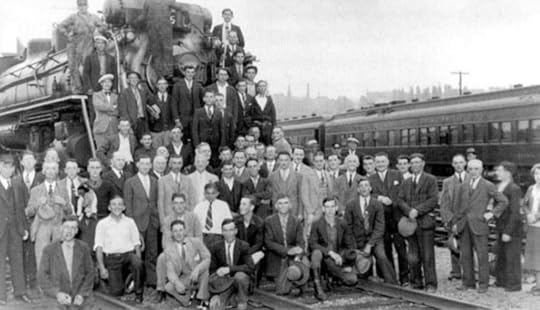
Ten years later, the Protestant Colonization and Land Settlement Society of the District of Montreal began their colonization project. On August 5, 1935, 25 settlers arrived by train in Rouyn.
Trucked in, they were let off where the dirt road ended, 3 miles west of Farmborough. Axe in hand, they followed narrow paths to their 100-acre allotments.
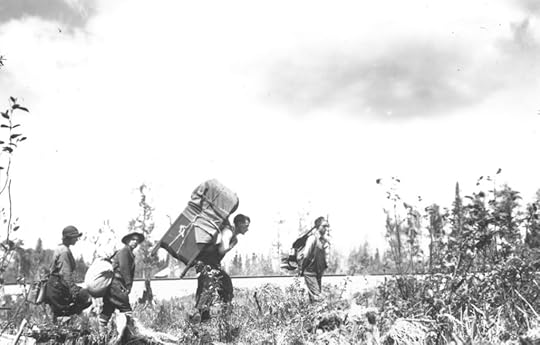
With only tents to live in, they were each expected to clear the bush, plant a farm and build a log house in time for winter. This was ‘black fly’ season, the ground muddy, and the city-bred men were inexperienced for such a formidable endeavour.
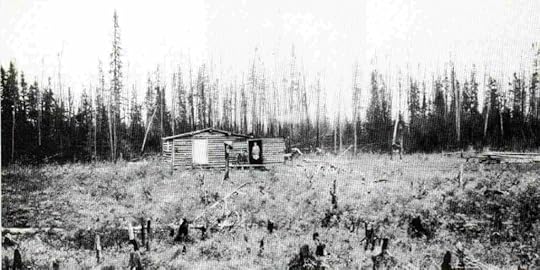
Abitibi homestead
The following year, 100 more settlers arrived and the colony began to take hold within the bush. Settlers were awarded $300 upon building a barn and could supplement their income with a small wage by working on local road construction.
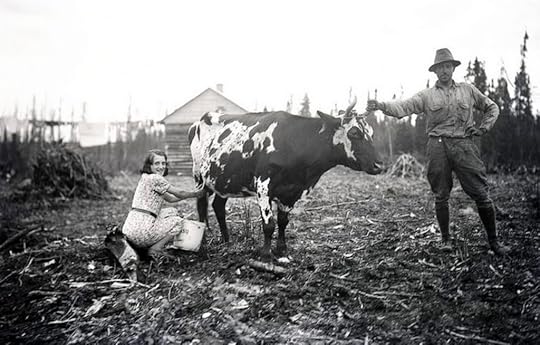
Being the last to colonize, the Protestant tracts were not a fertile as that of the earlier RC settlements. Top soil was only 2 inches deep over a layer of clay.
Poor quality of wood for house construction, and a short growing season with frost in June and July added to the settler’s hardship.
Yet, by 1937, a Protestant School and St. Mark’s Anglican church were completed. These buildings served as post office, dance hall and, twice yearly, a second-hand market (3). The Anglican colony struggled on, under the spiritual care of Reverend Gartrell, until he contracted polio, and then by Reverend George Loosemore, of St. Bede’s church in Rouyn.
In 1940, about 400 families were established in the Farmborough settlement.
“Life was tough but we survived,” said Ralph Hall, a 1936 settler (1). “There weren’t no fun in it, only what fun you could make out of it yourself.”
“We had some pretty good times,” reflected settler Herbert Moyle (1), 4 decades later, “because misery likes company.”
With the onset of world war, Farmborough’s population began to decrease. Settlement provision did not allow absence for military service. Since most of the settlers were mostly 3rd or 4th generation loyal English Canadians, of British ancestry, this was a serious lack of foresight. Property was confiscated despite obvious improvements, and the settlers received only $30—their original deposit. Remaining settlers were able to supplement income working in the mine or logging camps.
The community bonded with music, dance and protective protestant faith (another story to be told, someday). Soon, Farmborough music spilled out to the benefit of others eking out life in the north.
Lynda Lee Hanscomb and her sisters, Darlene and Jean sang with the ‘Northern Ramblers’ band, that included family friend Jim Stitchman and their father Ivan (4).
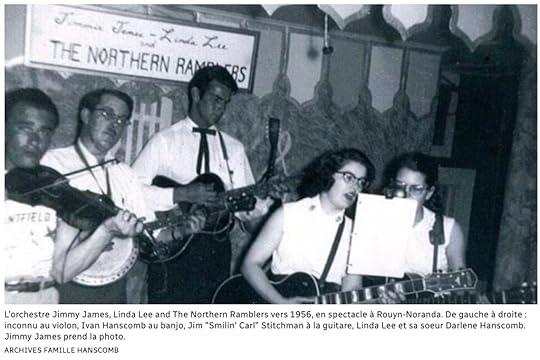
James Hines migrated to Farmborough, from Montreal in the 1940’s, with his family, in search for a better life (5). Borrowing Lynda Lee’s guitar, inspired by country music, he began singing under the name, ‘Jimmy James’. During the 1950’s, with his band ‘Les Candy Canes’, he’d signed with Columbia records, toured, and achieved both Toronto hit-parade and French country music fame throughout Quebec. He’d also married Lynda Lee.
By the mid-60’s (my time) only around 65 of the original settler families remained. Sunday afternoon services were still held at the Anglican church, presided over by the Noranda Anglican church of All Saints. St. Bede’s of Rouyn had closed as had the Farmborough and George Loosemore schools. If going through a rough time, one could find inexpensive housing, or temporarily squat on abandoned Farmborough homesteads.

We were also fortunate, to have Jimmy James and his band to sing at school concerts, when he was not on tour. This privilege of Nashville caliber entertainment, was because Jimmy James Jr. went to our school.
In 1971, the Quebec Provincial government cancelled colonization grants, and the Protestant Colonization and Land Settlement Society ceased operation (1). Colonization land allotment ended.
“There’s no way this place should have been opened up…there’s no *** way to do anything with this land,” complained a long-time farmer in 1975 (1).
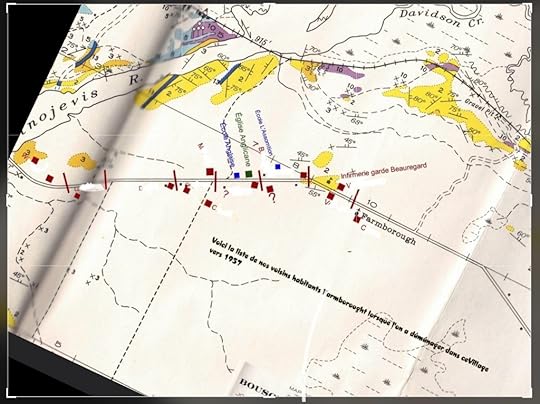
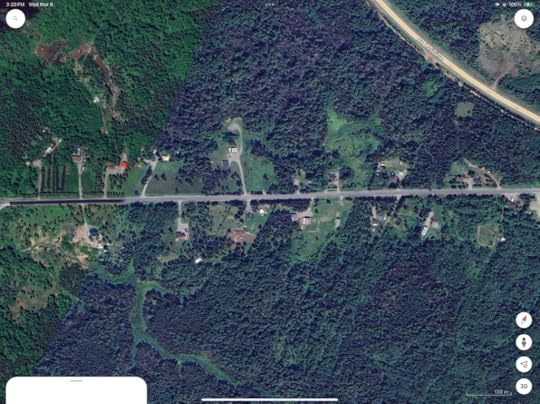
Side by side mapping of 1950’s Farmborough , showing location of Anglican Church and school with present day google map of existing buildings.
When I last passed through Farmborough, none of the original settlers nor their families remained. The bridge and highway had been rebuilt further north on the Kinojevis River. Anglican church and school had long-been razed and property unrecognizable. Rouyn-Noranda International Airport covered part of the settlement, with bush regrowth and newly constructed houses reclaiming much of the rest. Media search only revealed (7) Roman Catholic colonization and a nearby squatter community, near Malartic, burnt down in response to encroaching criminal activity.
Farmborough may be erased, but I can never forget the people.
These stoic pioneers endured much, seeking a better life—an example to be remembered.
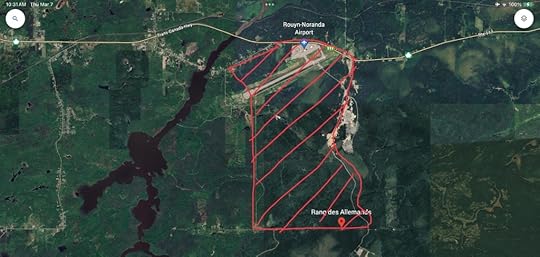
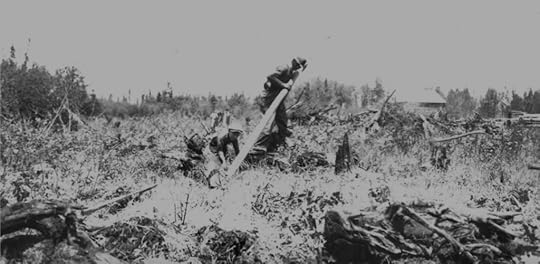
Approximate location of Farmborough settlement / settler and child clearing the land.
references:
(1) Farmborough Broke Backs and Dreams, Claude Arpin, The Montreal Star, July 30, 1975
(2) Wolf Lake First Nation, 20th Century. @wolflakefirstnation.ca
(3) Chronique histoire: le village disparity de Farmborough, January 27, 2020, Radio-Canada
(4) L’histoire de Linda Lee, pionniere de la musique en Abitibi-Temiscamingue, Radio-Canada, Region Zone 8, August 4, 2020
(5) Jimmy James, legend de la musique country d’Abitibi-Temiscamingue est decede, Radio-Canada, December 19, 2014
(6) Google Earth
(7) Facebook, McWatters Quebec. Merci a Grignon Michel, pour la carte de Farmborough
January 18, 2024
Where did Montreal’s Lac St. Pierre go?
A large lake and river appear on pre-1850 maps on Montreal Island (1). Present day, this area is dry land and accommodates the Turcot rail yard and traffic interchange (2) at the base of the St.Jacques cliff.
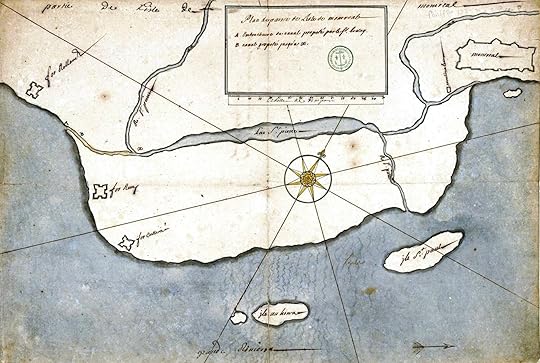
Had French explorers based their maps on indigenous ‘folklore’? Was this a mythological lake, much like dragons and sea monsters ascribed to unexplored reaches?
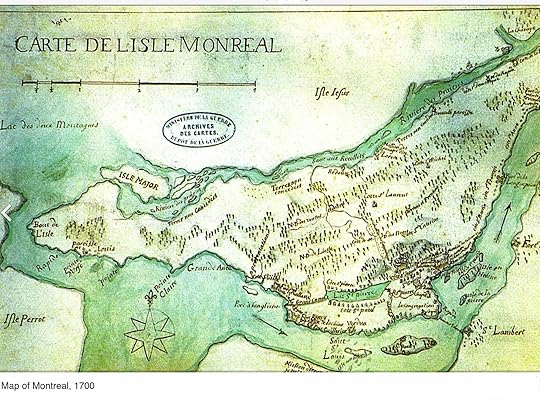 Figures 1 & 2: 1702 Map of Montreal Island
Figures 1 & 2: 1702 Map of Montreal Island Figure 3- Turcot rail yard and traffic interchange at base of St.Jacques cliff
Figure 3- Turcot rail yard and traffic interchange at base of St.Jacques cliff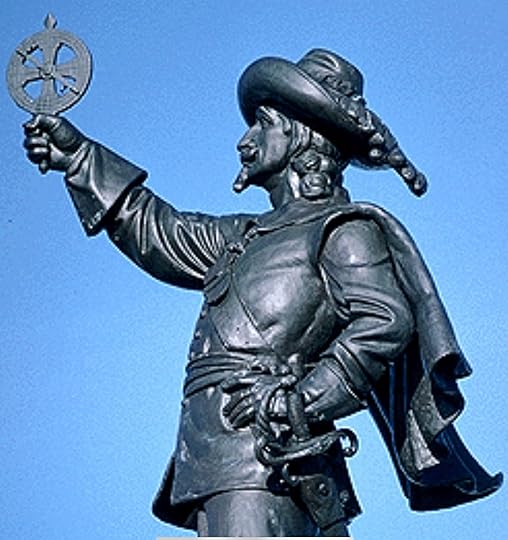
Perhaps this was an error from crude instrumentation early explorers relied upon. Yet, this instrumentation still remains in reliable use today. A compass is familiar to every hiker. The sextant is required on both ship and plane to determine longitude and latitude. A Pelorus, coupled with a lubber line, continues to be used in yachting to determine between vessels. Champlain’s useful astrolabe is also famous for having been lost in 1603 and found in 1867 in the upper Ottawa Valley.
Champlain would have used this astrolabe to measure the inclination of sun and stars from the earth’s horizon in consultation with astrological tables to fix the position of Lac St. Pierre and its inlet/outlet Rivière St. Pierre crossing Montreal island.
 Figure 3: Speculative model of Lac St. Pierre, 1600’s
Figure 3: Speculative model of Lac St. Pierre, 1600’s Lac St Pierre had existed…Where did it go?
In 1611, Samuel de Champlain described Petit Lac St. Pierre as “one of the finest spots on the St. Pierre River” . Water flowed from Mont Royale, in waterfalls over the St. Jacques cliff. Known as le Petit Lac St. Pierre, differentiating it from the St. Lawrence River’s widened reach, it as also referred to as Lac a la Loutre (Otter Lake) (3) due to an abundant presence of fish and wildlife.
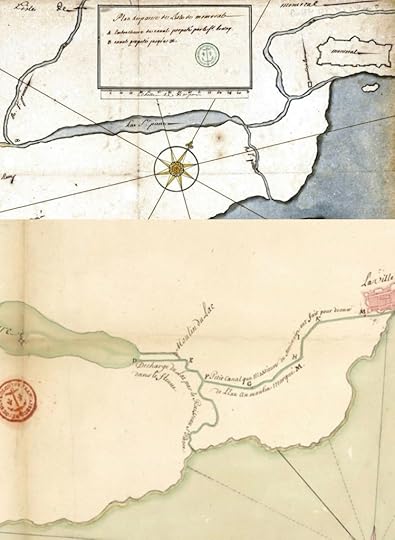
By 1640, the village of Montreal was established, nearby. Champlain ordered trees cut down on the shores of the lake, to make ready for building. He then proposed changing to the course of the Rivière St. Pierre, by digging the Saint Gabriel canal (4). This would allow canoe’s to bypass the Lachine Rapids, eliminating a lengthy portage. The canal would also provide sufficient discharge to run mills and feed industrial growth, west of Montreal.
Figure 4 (top): original river
Figure 4 (bottom): St. Gabriel canal.
Three four mills (9) and several tanneries, in support of the French fur trade, were subsequently located on the banks of the St. Pierre lac and rivière. Complementary industries, of tallow factories and slaughter houses, soon followed.
Figure 5: Populated shores of Lac St. Pierre (early 1700’s)
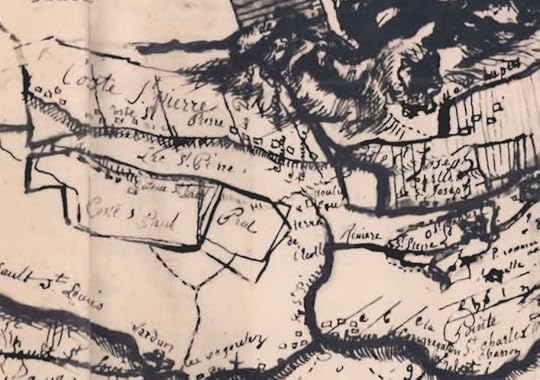
The tanning process, converting hides into rawhide and leather, required softening skins in a lime pit, pounding skins to remove flesh and fat, before soaking them in urine, painting with a lime mixture and finally soaking them in a tanning solution of eggs, brain and other noxious solutions. The former pristine waters of St. Pierre transformed into a swampy open sewer of industrial refuse, toxic wastewater and human sewage.
Figure 6, a 1815 map (5) of Montreal, shows Lac St. Pierre, with the Rivière St. Pierre, flowing through Verdun, to Isle St. Pierre (present-day Nun’s Island). A small tributary still flows over the high embankment to the north.
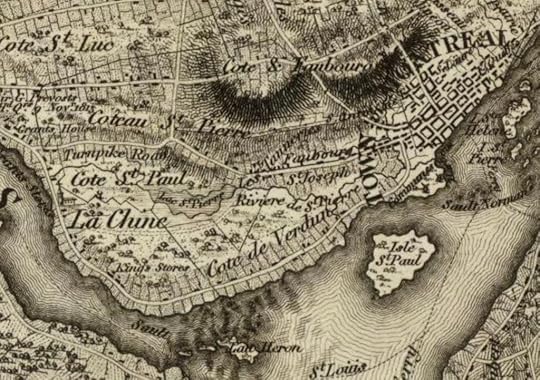 Figure 6: 1815 map, west of Montreal
Figure 6: 1815 map, west of Montreal By 1831 (6), Lac St. Pierre disappeared from a survey of Montreal. Rivière St. Pierre was still visible, north of the newly constructed Lachine canal. The Tannery district is identified, to the west of the city and north of the ‘little River’ and Lachine canal.
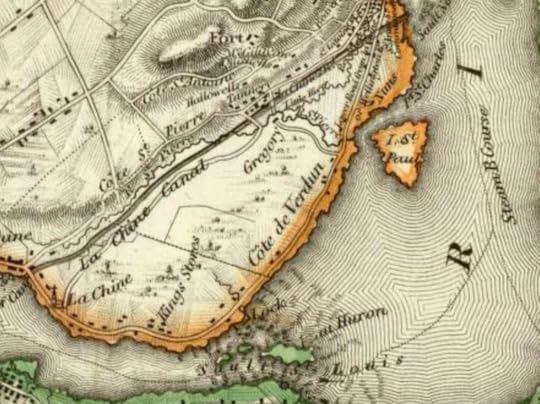 Figure 7: 1831 map, west of Montreal
Figure 7: 1831 map, west of MontrealBy 1825, the ‘politically charged’ construction of the 4.5 km Lachine Canal was completed, and extended from the Port of Montreal to the widened reach of Lac St. Louis of the St. Lawrence River. In my research I found no mention of material deposition, however, rock blasting, digging by hand was done by Irish labourers, and carted away by wagon (7)(9). Excavated materials were likely conveniently deposited into the nearby now-swampy and polluted basin of Lac St. Pierre.
From Figure 7, one can see the Rivière St. Pierre runs adjacent and was not incorporated into the canal, except for a small redirected portion. This was required to accommodate snow runoff, collecting in the former Lac St. Pierre basin, flooding the excavation. In the spring of 1824, the Rivière St. Pierre turned into a torrent, further necessitating construction of tunnel, allowing Rivière St.Pierre to flow under the canal (8).
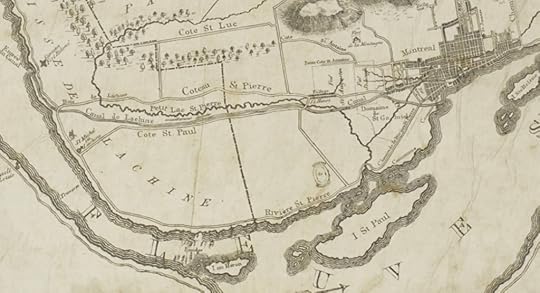 Figure 8: Lachine Canal and Petit Lac St. Pierre, 1834
Figure 8: Lachine Canal and Petit Lac St. Pierre, 1834In 1832, in the interest of public health, 350 meters of the foul Rivière St. Pierre was diverted into a vaulted stone conduit, known as the William Collector. Gradually, more of the Rivière disappeared into Montreal’s growing sewer system(10). With time, occasional artifacts of the former, buried and forgotten, Lac and Rivière would surface (11).
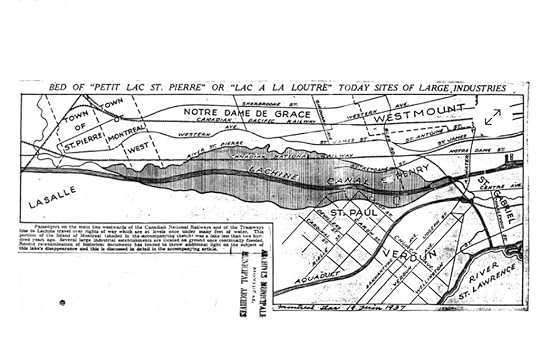 Figure 9: Montreal Star article, June 19, 1937 (text inscribed below)
Figure 9: Montreal Star article, June 19, 1937 (text inscribed below) “Passengers on the main line, westwards of the Canadian National Railways, and of the Tramways line to Lachine, travel over rights of way which are at levels once under many feet of water. This portion of the Island of Montreal (shaded in the accompanying sketch) was a lake less than 200 years ago. Several large industrial establishments are located on ground once continually flooded.” (11)
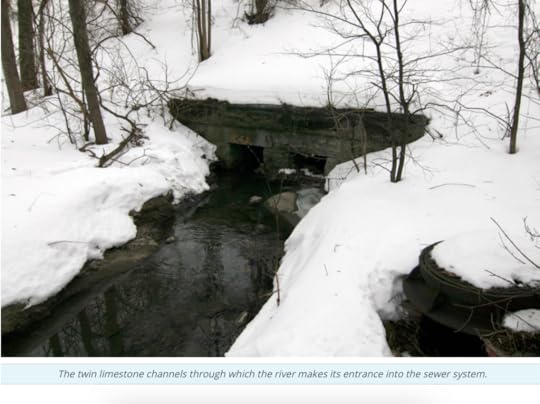
Figure 10: Only a 200 meter remnant of the Rivière remains, a contaminated creek traversing Meadowbrook Golf Club, in Montreal West (12).
An environmental group, ‘Les Amis du Parc Meadowbrook, is working to protect the remain of this historical waterway.
Adjacent to the Lachine Canal a memorial has been built, a reminder of the Lac.
Figure 11: Memorial to the St. Pierre Lac and Rivière.

Les Amis du Parc Meadowbrook has published an enlightening map of other waterways that have disappeared into Montreal’s sewers. (13)
 Figure 12: Montreal Island’s waterways, existing and lost
Figure 12: Montreal Island’s waterways, existing and lostAnd that is the sad fate of Montreal’s Lac St. Pierre.
References:
(1) Description generally de L’isle de Montreal, Coste de Francois Vachon de Belmont, 1802, Archives de la Ville de Montreal
(2) Google Earth Maps
(3) La Petit Lac Saint-Pierre et la Falaise Saint-Jacques, 1 July, 2022, souvenirsetmemoirescdn.com
(4) Saint Pierre River (Montreal) — Wikipedia
(5) Topical Map of the Province of Lower Canada, 1815, David Rumsey Historical Map Collection
(6) Map of the District of Montreal, Lower Canada, 1831, David Rumsey Historical Map Collection
(7) The Construction of the First Lachine Canal, 1815-1826, J.J.Tulchinsky, June 1960, MA Submission, McGill University
(8) Building the Lachine Canal, Janice Hamilton, March 15, 2015, Genealogyensemble.files.wordpress.com
(9) The St. Pierre River: Remembering a Historical Montreal Waterway, L.Legault, Friends of Meadowbrook Park
(10) Following Rivière St. Pierre, Montreal’s Most Famous Lost River, 5 Part Series, March 3, 2009, Spacing, Canadian Urbanism Uncovered
(11) Montreal to Bury St. Pierre River on Meadowbrook Golf Course, Marian Scott, Nov 18, 2021, Montreal Gazette
(12) Montreal Island Lost Rivers, Marian Scott, July 9, 2018, Montreal Gazette
November 3, 2023
Kept Safe
Kept Safe… – Catherine Grove
Napoleonic and American Wars are ending. England’s Regency empire is expanding. Industrial Revolution is stirring unrest. Entitled Olivia Fairworth is out of excuses. A cryptic message offers escape to British America. Exasperated Captain Wesley Bryson risks scandal. Wits and wills clash. Pride and ambition provoked, they ally. Travel with them to the Canadian frontier,on untamed…
— Read on catherinegroveauthor.ca/kept-safe-3/
June 22, 2023
Country Wives and Country Marriages in the Manner of the Land (à la Façons du Pays)
Let’s give Indigenous Foremothers due consideration and respect for their contribution to the peaceful economic development and settlement of Canada. Through marital union in their ‘manner of the land’ they made a significant contribution to the economic development and settlement of Canada. Let’s give these women the recognition they deserve.
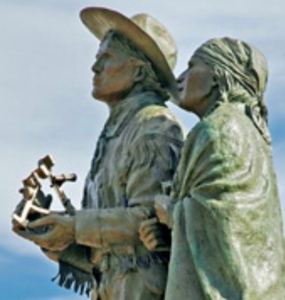 David Thompson and Charlotte Small
David Thompson and Charlotte SmallHistory is subject to period sensibility. What was thought acceptable, today would be deemed exploitive. Yet, is it fair to occlude the immense contribution of indigenous women from Canadian History? Humanity is not easily categorized into right and wrong behaviors. Understanding what occurred, is not agreeing with what occurred.
New France
Early in the French Canadian colonization, Catholic clergy of New France/Lower Canada frowned upon marriages with First Nations women. In response, provision of ‘Kings Daughters’, 800 French women ‘of good character’, was sponsored by King Louis XIV between 1663 and 1673. The intention of this immigration was to correct the woeful imbalance of ‘available’ women with European fur traders, settlers and French soldiers.
Fortunately, arrival of these ‘Kings Daughters’ did not dissuade ‘country marriages’ from continuing with local women. Indigenous marriages strengthened Quebec’s genetic pool of a small number of colonists of the Canadian St. Lawrence Valley. Present day genetic analysis/sampling of Quebec’s population, that identifies as ‘non-indigenous’, indicates at least one Native ancestor 6 to 7 generations ago(3). This indigenous admixture prevented genetic susceptibilities of the small isolated population resulting in few genetic ‘Founder Effect’ diseases observed. Between 53% to 78% of Quebecois have at least one indigenous member in their genealogy.
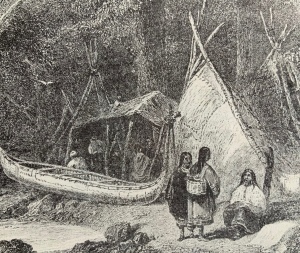
Hudson Bay
In 1660, the Hudson Bay Company (HBC) held a virtual fur trade monopoly over the Hudson Bay. Approximately 80% of company employees were recruited from remote northern Orkney Islands of Scotland. These men were considered best to cope with the northern Canadian maritime environment. This offer of escape from poverty came in exchange for a 5-year indenture, with wives and families prohibited from accompanying them(1). HBC officers were allowed accompanying families, but few wives were willing to trade England’s comforts for a lonely northern trading post. HBC indentured employees (servants) were forbidden from relationships with local indigenous women who were also banned from trading posts to limit interaction.
As HBC expanded inland in pursuit of trade, competition with the Montreal-based North West Company (NWC) escalated. All ranks of the NWC had already embraced the practice of extensive intermarriage ‘in the manner of the country’ with their indigenous trading partners(2).
To maintain economic advantage over the NWC, HBC servants were required to press further inland for trade. HBC, by end of the 1700’s, had accepted the necessity of indigenous female for this to be successful. HBC servants lacked essential knowledge and skills to survive harsh, remote, lonely outposts. Trade loyalty had to be developed and maintained with their indigenous trading partners.
European men were neither experienced nor trained to survive in the harsh, unfamiliar Canadian northern climate. Neither was the fur trade industry. Trade relied on goodwill with the indigenous population. The solution of marital union was obvious. An indigenous wife would provide companionship, essential domestic skills for food and clothing, translation, in addition to securing a trade advantage through family kinship. She could also serve as diplomat, cultural advisor, interpreter, and provide the vital knowledge and labour needed in preserving furs for export to Europe. Any relations with native women had to be viewed as beneficial to both parties.
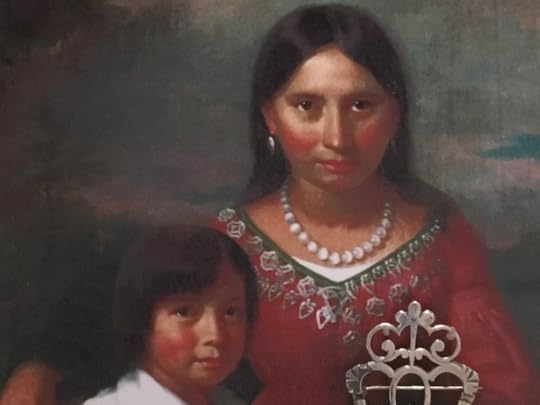
With this understanding, HBC began to actively encourage marital union ‘in the manner of the country’ between employees and Indigenous women of their trade areas. This ‘Country Marriage’ was taken seriously, even officiated by the overseeing HBC official, and was ‘consecrated’ with an agreed bride price paid to her family following local custom.
Both parties benefited. The husband gained a spouse integrating him into the society with which he traded. The woman gained status and economic benefit: their offspring and her extended family received employment and loyalty of the HBC. That a man had wife and family back in Orkney was of little concern. In the ‘manner of the country’ a man could have more than one wife if he could support both. Indigenous practicality also did not view marriage as permanent. It was understood that both parties could leave if dissatisfied or the union was no longer of benefit.
Explorers
One of the most famous of ‘country wives’ is Sacagawea, the younger of two country Shoshone wives of French Canadian fur trapper Toussaint Charbonneau. She served as translator and diplomat on the Lewis and Clark Expedition (1804-1806). President Thomas Jefferson commissioned this expedition to explore and map newly acquired territory from the Mississippi River to the Pacific Ocean, in order to claim the western half of the United States.
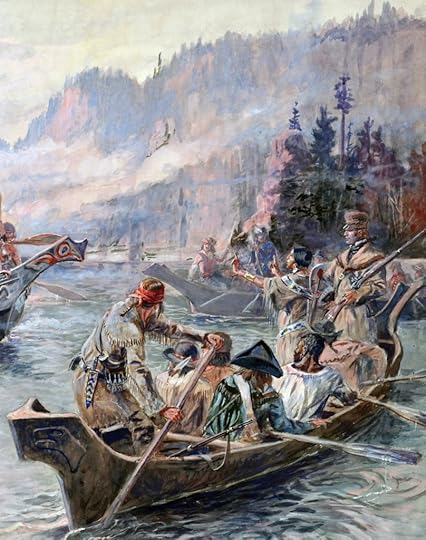
Meriwether Lewis called the ill-reputed Charbonneau ‘a man of no particular merit’ yet was forced to hire him to acquire the services of Sacagawea. William Clark, expedition leader, reprimanded Charbonneau for beating Sacagawea. Charbonneau was paid, his wife was not though she proved a significant asset for feeding and clothing the expedition, as well as serving as a diplomat and translator(4). Today, this indigenous woman has acquired almost mythological status.
Yet she died, 6 years after the expedition, abandoned by Charbonneau, and William Clark adopted her children
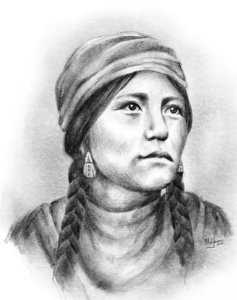
Charlotte Small, wife of explorer and cartologist, David Thompson also served as translator (Cree, French, English) and diplomat. At age 29 Thompson married this 13-year-old Metis Cree girl ‘in the manner of the country’. She was the product of a ‘country marriage’, in which her father abandoned her family to return to Scotland. Accompanying Thompson, Charlotte’s first child was born at age 15 and 12 others followed.
Thirteen years after their common law ‘country’ union, the marriage was formalized at a Scotch Presbyterian Church in Montreal. Their marriage is recognized as the longest pre-confederation marriage, lasting 57 years, including those years ‘in the manner of the country’.
James McMillan, who travelled with David Thompson, took Josephte Belisle, as a ‘country wife’ in 1806 and had 2 children with her. He went on to have 2 more ‘country wives’, Marie Letendre and Kilakatah, and numerous children. Obeying indigenous customs, before he returned to Scotland to marry a Scottish bride, he married his ‘country wives’ to responsible partners and ensured his sons were offered opportunities in the fur trade. Josephte Belisle married Amable Faforddit Delorme and had 5 more children. Widowed in 1835, she applied for and received compensation from NWC as Josephte McMillan.
Both HBC and NWC honored their commitment to care for these ‘country marriages’ and provided opportunity for their offspring. Mary Sinclair Inkster (1804-1892), born of a ‘country’ union between a Cree woman, Nahoway, married William Sinclair (1794-1868), resourceful Chief Factor of HBC Winnipeg District. William Sinclair was also an offspring of a ‘country marriage’ between an Orkney fur trader and a Cree woman.
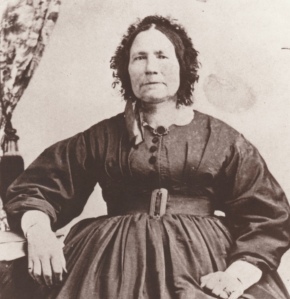
Legality of Indigenous Marriage recognized
‘Country marriage’ was considered a valid union under the concept of common law marriage. The offspring of such unions had recognized and legal rights. An intriguing case of ‘country marriage’ involves the union of Magdeleine Poitras, ‘country wife’ of John Macdonell, known as ‘Le Prêtre’ because of his devout Catholicism. Sometime before 1797 he took her as his wife at the age of 12. ‘Under my protection’ he claimed, their marriage resulted in 6 children. In 1813 he drew up a marriage contract, just before purchasing land, and built a large house for his family on the Ottawa River.
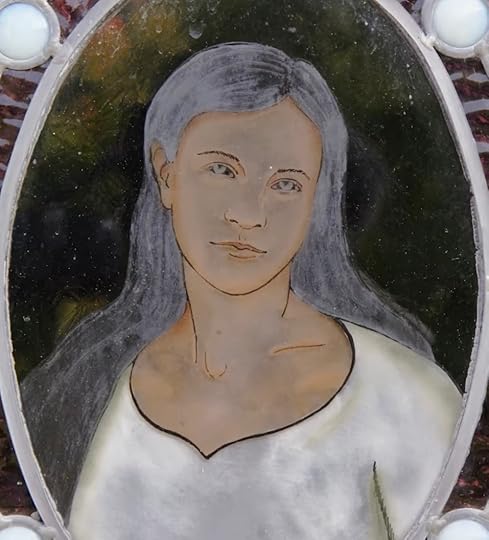
The marriage was never solemnized, after the contract. His will divided his property equally between their children, providing an annuity to Magdeleine. Three years after his death, in 1850, Magdeleine underwent a post-humorous marriage ensuring their union and inheritance was recognized and upheld(6).
William Connolly, an Anglo trapper of the NWC married, ‘according to local custom’, a Metis Cree woman, Miyo Nipiy (also known as Susanna Pas de Nom), when stationed at Manitoba. Together they had 6 children and in 1832 he took the family back to Montreal. Disavowing their ‘country marriage’, he instead married Julia Woolrich in a Catholic ceremony. His Metis family returned to Manitoba where Susanna retreated to a Grey Nuns convent. When he died in 1848, his eldest Metis son sued the estate arguing that he and his siblings were legitimate heirs and his argument was upheld by the Supreme Court of Upper Canada. Appeal to the Privy Council of the United Kingdom resulted in Julia Woolrich settling out of court(5). This judgement validated the concept of ‘First Nations Country Marriage’ underpinning Canadian common law.
William Connolly’s daughter, Amelia, fared better than Suzanna. In 1828, at age 15, he officiated her ‘country marriage’ to James Douglas, a mixed-race trapper of Scottish and African descent(7). Douglas was an illegitimate son of a Barbadian planter merchant and a free coloured woman. Amelia spoke Metis French, Cree and very little English and bore him 13 children, 6 of whom survived to adulthood. Their country union was solemnized in 1836 to appease growing disapproval among European wives of fur trade officials. A feuding feisty man, Douglas rose in the ranks of NWC and later transferred to HBC. He was appointed Governor of the Colony of Vancouver Island (1851) and, in 1858, Governor of the Crown Colony of British Columbia. Amelia Douglas provided calming intervention in his tumultuous relations with local indigenous people. In 1864 James Douglas was knighted by Queen Victoria and Amelia was titled Lady Douglas.
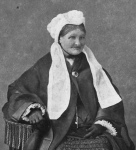 Lady Amelia Douglas
Lady Amelia DouglasMany notable European men, ill-equipped for life in Canada’s wilderness, took ‘country wives’ who enabled their distinguished contributions. Yet few of these women are recognised in history(8).
Alexander Mackenzie, Scottish explorer and fur trader, accomplished the first land crossing of North America in 1793. Enroute to Fort Chipewan, he made a ‘country marriage’ with Catt. Little is known of this woman, but a son came from this union, Andrew, who entered the fur trade and became a NWC clerk. At age 48 Mackenzie returned to Scotland to marry a 14-yer-old heiress.
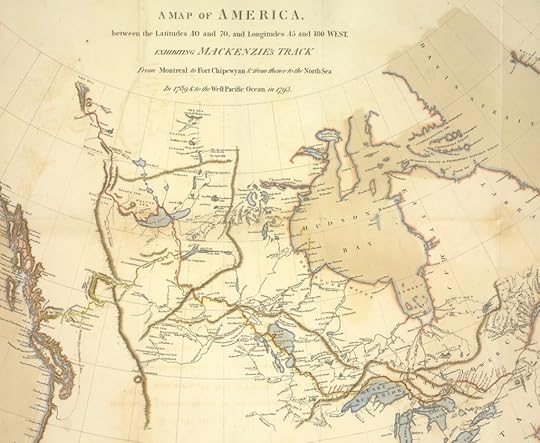 Continental Journey of Alexander Mackenzie
Continental Journey of Alexander MackenzieSimon Fraser, fur trader and explorer, who charted much of British Columbia, had more than one country wife, for in 1807, he recorded, “Once more entered into the matrimonial state”. At age 44 he returned to Cornwall to marry Catherine McDonell in 1820.
George Simpson, Governor in Chief of HBC, fathered 11 children with 7 women, between 1821 and 1860. One of his former wives, Margarite Taylor, he belatedly married off, in a solemnized ceremony, to Amable Hogue, one of his paddlers of the HBC who later became his mason(9)(10).
Fur Traders in their own Right
Some ‘country wives’ became fur traders. Magdelaine La Fromboise (1781-1846), of mixed Odawa and French descent, began managing her husband’s business after his murder in 1806. She expanded the business and funded a school and missionary work on the Mackinac Island. Although, technically located in present day Michigan, her father was chief agent for the NWC and she viewed Montreal as her base of operation.
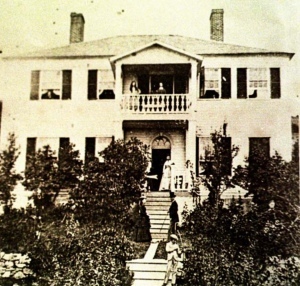 Home of Magdelaine LaFromboise
Home of Magdelaine LaFromboise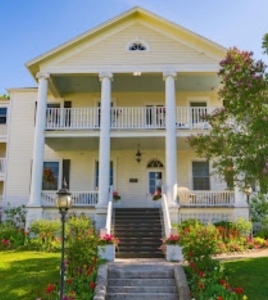 Present day, Mackinac Island
Present day, Mackinac IslandIn conclusion:
By the 1830’s, Canada’s settlement made immigration more hospitable for European women. European men abandoned Native wives for ‘preferred’ European women. The growing missionary presence condemned marriage by ‘Indian rules’ and the condition of indigenous women living with European men deteriorated. Country marriages that were once considered an integral part of Canadian settlement, suddenly became shameful. These women disappeared from Canadian history, becoming a mere footnote.
Exploration, economic development and peaceful settlement of Canada was accomplished by men, with an indigenous wife at their side bridging cultural, linguistic and climatic challenges. These indigenous women are due historical consideration and respect. Without them, our Canada would be vastly different. Without them, perhaps, under the Doctrine of Discover (1823) Canada might not exist.
References:
Manitoba History: ‘Covenant Servants’: Contract, Negotiation and Accommodation in Hudson Bay 1670-1782, Scott Stephen, Manitoba Historical Society, N. 60, February 2009Women of the Fur Trade, and marriage ‘a la façons du pays’, April, 2019. La Compagnie (hsp-mn.org)Native American Admixture in the Quebec Founder Population, C.Moreau, J-F Lefebvre, M.Jomphe, C.Bherer, A. Ruiz-Linares, H. Vezina, M-H. Roy-Gagnon, and D.Labuda. National Library of Medicine, 2013 June 12 (10.1371/journal.pone0065507)Sacagawea, Native American explorer, J.H.Buckley, Britannica (brittannica.com)William Connolly (fur trader), WikipediaJohn McDonell, Dictionary of Canadian Biography by Herbert J. MaysJames Douglas, Father of British Columbia, Dorthy Blakey Smith, 1971, Oxford University PressThe Role of Native Women in the Fur Trade Society of Western Canada (1670-1830), S.Van Kirk, Frontiers: A Journal of Women Studies, V.7, No.3 As Canadian as Can Be, (hoguegiradin.wordpress.com)(10)Women in the Shadows (1991), the story of Margaret Taylor(www.nfb.ca )
March 30, 2023
Catherine Grove interviewed by Hilda Frances Young (March 31/22)
When did you first publish your writing in book form?
:-> My first book, Never Forget, was published in 2019. Never Far, its stand- alone sequel, was published in 2020. Background: My Publisher, recommended I make a logical break in the story, subdividing the book into a series. More marketable is a book series by a new author, than a large book.
 Enjoying a scone, Edinburgh Castle, April 2018
Enjoying a scone, Edinburgh Castle, April 2018Is your third book a continuation of this story line?
:-> My third book, Kept Safe, is a stand-alone story, running parallel to the story line, continuing along the time line of history. Back stories of characters you meet in Never Forget and Never Far are developed in Kept Safe. I was architecting Kept Safe in parallel to working with my Editors for Never Far and Never Forget. Doing so enabled continuity among the books. The reader who first reads Kept Safe will have an enriched encounter when they first read Never Forget and Never Far.
In your bio notes you mention liking history and trying to live it. How do you combine that with modern life?
:-> This is a provoking question. For me, history cannot be separated from modern life. Our lives are in a continual flow of local, regional, national and global events. We are shaped by past, prevailing and new attitudes plus perspectives. Choices made over 200 years ago, cascade through today’s events: Indigenous reconciliation, land claims, government compensation, natural resource management, systemic racism, gender inequality, social justice, political sovereignty and authentic faith. We can improve our future by learning from our past.
:-> Through historical fiction, I endeavour to bring truth to life.
:-> An active member, I participate in several historical societies. I research and visit historical sites, on line and in person. I keep current on world events and read relevant non-fiction, for example history.
I notice that the cover photos for both books are the same. How did you choose the cover and the photographer?
:-> The book covers are intentionally similar. The books are related. The commissioned photos were selected to illustrate Janet’s world was opening up to possibilities. Like many of us, the life choices Janet faces are neither simple nor easy. Readers join her as she endeavours to live beyond her limits. Book 1, Never Forget, looks out on a dawn. Book 2, Never Far, looks from a rocky foot hold. Both look onto a limitless horizon.
How long does it take for you to research and write a book?
:-> A long time. I am researching a world, I want to bring to life. Stories emerge to fill in and communicate historical facts as lived out by real and fictional characters. As I write I am continually fact-checking to decorate and tune the story line to be anchored in history. I want the reader to live the character’s life, understand their thoughts and actions, within the context of their world.
:-> Reviewers and readers have told me, they were drawn back in time, into the past world. Many felt they’d become friends with Janet.
I appreciate the list of “characters” at the beginning of the book as it gets confusing when so many names are mentioned as I realise they are part of both books. You appear to focus on the people .
:-> I value keeping track of names in the book. I’ll make my own list if the author hasn’t provided it for me. I thought my readers would like that, too.
:-> People enjoy reading about people. I bring characters to life, to provide a story, which will bring history to life for the reader. Overlaying characters’ hopes, choices and consequences on accurate history, provide a rich tapestry for the reader.
Do you think setting is important in your stories?
:-> YES. A period of time, in history provides a natural setting. An existing framework is provided for the story teller to live out their story.
:-> Reading about choices made 200 years ago, in their context, enhances today’s readers’ understanding of the same topics: Indigenous reconciliation, land claims, government compensation, natural resource management, systemic racism, gender inequality, social justice, political sovereignty and authentic faith.
:-> Actual and fictional characters of 200 years ago, like today, were confined to geography, station in life and culture. These influence vision and opportunity. Reading about their world view enhances our view of the world.
How did you plan on connecting the two life styles of the colonial and the more staid Regency?
:-> I suggest history records British North America as Conservative and modeled after Britain. The “second son” of an aristocrat would make a life for themselves in the Colony since the “first son” would inherit the family estate. Aristocratic entitled behaviour in the Colony caused economic and social injustice. Within 20 years of these books, Canada faced two rebellions, in both Upper and Lower Canada.
:-> Based on my research, Regency culture and Colonial life were connected through economic endeavours and turbulent social change. Mass migration occurred with tenants being cleared off their ancestral land in Scotland and England. Indigenous refugees made their north way from the American Wars. The industrial revolution had started and poverty was viewed a punishable crime: work houses were established, and people indentured to pay their debts. Slavery was legal in Canada alongside free Black American land- owning refugees. Under Common Law in Upper Canada, upon marriage, a women ceased to exist as a legal entity, and was considered ‘hidden’ within her husband’s identity. The law forbade a married woman from owning property, earning money or making her own decisions. Surprisingly to many, under Civil Law in Lower Canada, land-owning married women had the right to vote for their Legislative representatives. These inequalities play out through the characters in my stories.
:-> People live, love and strive to follow their dreams. The new world provided a possibility to do this. I want to tell their courageous stories, both fiction and non-fiction.



